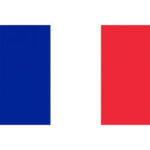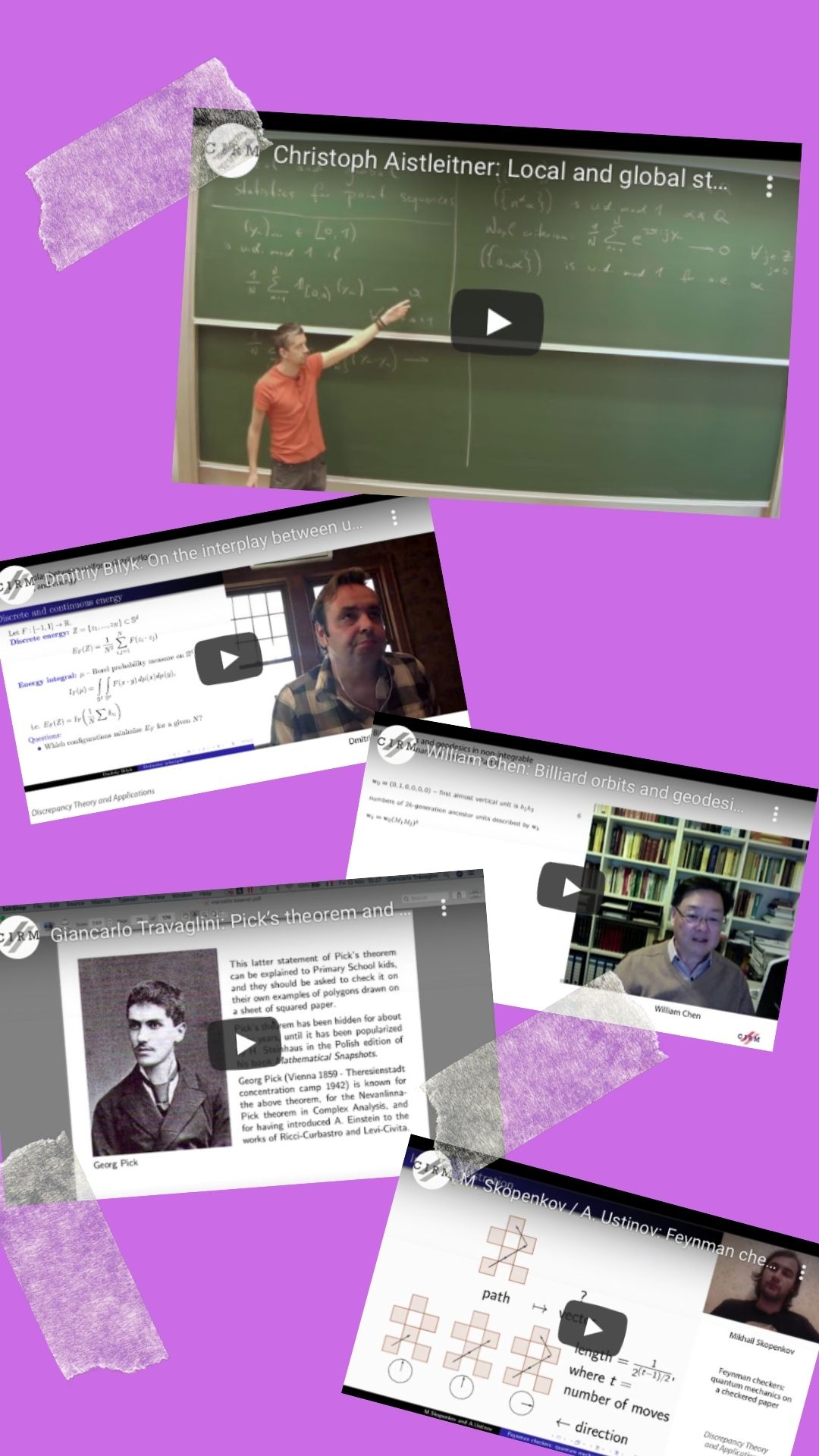VIRTUAL WORKSHOP
30 November – 1 December 2020 (Part 1)
Discrepancy Theory and Applications
Théorie de la discrépance et applications
CIRM – Jean-Morlet Chair – Robert Tichy & Joël Rivat
|
KEY WORDS
The scope of the workshop covers:
SCIENTIFIC COMMITTEE
ORGANIZING COMMITTEE
|
RECORDED TALKS
All these videos are available on CIRM-YouTube channel. You can also find them indexed and enriched with metadata on CIRM – AV Mathematics Library, a sophisticated platform built on a corpus of talks given by worldwide mathematicians during their stay at CIRM.
|
|
Abstract. We recall some classical results for uniform distribution modulo one, and relate them with their counterparts in the « localized » setting of correlation functions and gap statistics. We discuss the difficulties arising from the localized setting, with a particular emphasis on questions concerning the almost everywhere behavior of parametric sequences. It turns out that in this metric setting one is naturally led to a Diophantine counting problem, which has interesting connections to additive combinatorics and to moment bounds for the Riemann zeta function.
|
|
|
Dmitriy Bilyk (University of Minnesota)
On the interplay between uniform distribution, discrepancy, and energy Abstract. Discrepancy and discrete energy are two of the most standard ways to measure the quality of the distribution of a finite point set, and it is very well known that there is strong interplay between these concepts. One particular important example of such interplay is the classical Stolarsky principle which ties together the pairwise sum of distances and the spherical cap discrepancy. In the current talk we shall survey various manifestations of this connection between discrepancy and energy minimization.
|
William Chen (Macquarie University)
Abstract. We are primarily concerned with the distribution of billiard orbits and geodesics in nonintegrable flat dynamical systems, those that exhibit split singularities. This is an area which has been studied over a number of decades by different authors, and many deep results have been obtained.We are particularly interested in results concerning density and uniformity. However, until very recently, the major known results are time-qualitative and do not seem to say anything definite about the necessary time range. Their proofs all use Birkhoff’s ergodic theorem, which is quantitative in the sense that it can tell us precisely how often some relevant event is going to take place, but time-qualitative in the sense that it requires unlimited time range.This leads to a very natural question as to what can happen in a realistic finite time scale.In these two talks, we describe a new non-ergodic method which is a combination of combinatorics, number theory and linear algebra, and which leads to time-quantitative results concerning density and uniformity of some billiard orbits and geodesics in many nonintegrable flat dynamical systems. We discuss two versions of the technique, an eigenvaluebased version as well as an eigenvalue-free version which relies on size magnification.This is work with Jozsef Beck, Michael Donders and Yuxuan Yang.
|
Billiard orbits and geodesics in non-integrable flat dynamical systems
(part 1)
|
Billiard orbits and geodesics in non-integrable flat dynamical systems
(part 2)
|
Florian Pausinger (Queen’s University Belfast)
Abstract. In this talk I will report on recent progress on two different problems in discrepancy theory.In the first part I will present a recent extension of the notion of jittered sampling to arbitrary partitions of the unit cube. In this joint work with Markus Kiderlen from Aarhus, we introduce the notion of a uniformly distributed triangular array. Moreover, we show that the expected Lp-discrepancy of a point sample generated from an arbitrary equi volume partition of the unit cube is always strictly smaller than the expected Lp-discrepancy of a set of N uniform random samples for p > 1.The second part of the talk is dedicated to greedy energy minimization. I will give a new characterisation of the classical van der Corput sequence in terms of a minimization problem and will discuss various related open questions.
Part 3: Greedy energy minimization and thevan der Corput sequence
|
|
|
Alexey Ustinov (Pacific National University)
Mikhail Skopenkov (Higher School of Economics) Feynman Checkers: Number theory methods in quantum theory
|
Abstract. In the 40s R. Feynman invented a simple model of electron motion, which is now known as Feynman’s checkers. This model is also known as the one-dimensional quantum walk or the imaginary temperature Ising model. In Feynman’s checkers, a checker moves on a checkerboard by simple rules, and the result describes the quantum-mechanical behavior of an electron. We solve mathematically a problem by R. Feynman from 1965, which was to prove that the model reproduces the usual quantum-mechanical free-particle kernel for large time, small average velocity, and small lattice step. We compute the small-lattice-step and the large-time limits, justifying heuristic derivations by J. Narlikar from 1972 and by A.Ambainis et al. from 2001. The main tools are the Fourier transform and the stationary phase method. A more detailed description of the model can be found in Skopenkov M.& Ustinov A. Feynman checkers: towards algorithmic quantum theory. (2020) https://arxiv.org/abs/2007.12879
|
|
Giancarlo Travaglini
(Università degli Studi di Milano – Bicocca) Pick’s theorem and Riemann sums: a Fourier analytic tale Abstract. We show a connection between Fourier series and a celebrated theorem of G. Pick on the number of integer points in an integer polygon. Then we discuss an EulerMaclaurin formula over polygons.
|
|



